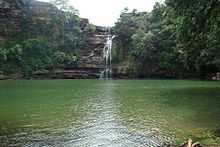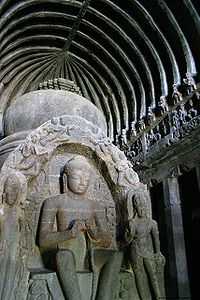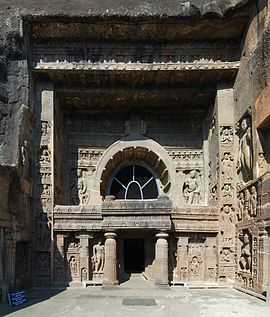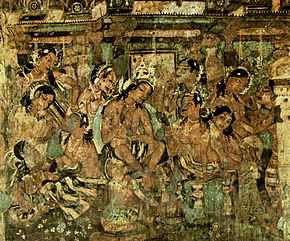Gandhi Sagar Sanctuary
| Gandhi Sagar Sanctuary | |
|---|---|
|
IUCN category IV (habitat/species management area) | |
|
River Chambal in Gandhi Sagar Sanctuary | |
 Map of India | |
| Location |
Mandsaur and Nimach districts Madhya Pradesh, India |
| Coordinates | 24°34′59″N 75°42′43″E / 24.583°N 75.712°ECoordinates: 24°34′59″N 75°42′43″E / 24.583°N 75.712°E[1] |
| Area | 368.62 km2 (142.32 sq mi) |
| Established | 1974 |
Gandhi Sagar Sanctuary (Hindi: गांधी सागर अभयारण्य) is a wildlife sanctuary situated on the northern boundary of Mandsaur and Nimach districts in Madhya Pradesh, India. It is spread over an area of 368.62 km2 (142.32 sq mi) adjoining Rajasthan state in India. It was notified in 1974 and more area was added in 1983. The Chambal River passes through the sanctuary dividing it into two parts. The western part is in Nimach district and eastern part is in Mandsaur district.
Flora and fauna
The Sanctuary is open throughout the year. With a varied terrain of wooded hills – the forest being dry, mixed and deciduous- and flat grasslands around Gandhi sagar dam submergence, it offers abundant opportunities of sighting a variety of wildlife. The principal tree species found in the Sanctuary are Khair (Acacia catechu), Salai, Kardhai, Dhawda, Tendu, Palash etc.
The Predominant wild animal species that inhabits the Sanctuary are the deer, of which the most easily sighted are chinkara or Indian gazelle, nilgai, sambar, leopard,common langur, wild dog, peacock, otter, crocodile etc.
Places archaeological and religious importance
Sanctuary has many places of historical, archaeological and religious importance. These are Chaurasigarh, Chaturbhujnath temple, Bhadkaji rock paintings, Narsinghjhar, Hinglajgarh Fort, Taxakeshwar temple etc.
Chaturbhujnath (hindi:चतुर्भुजनाथ) temple is about 8 km from Gandhi sagar dam site. There is a statue of Lord Vishnu in this temple. A fair is organized here on the occasion of Tejaji dashami, tenth day of the month of Bhadra Hindu month to mark the birth of Tejaji. Very near to this temple is the site of Bhadkaji (hindi:भड़काजी) rock paintings of period about 1400 years old.
Hinglajgarh

Hinglajgarh (Hindi: हिंगलाजगढ़) or Hinglaj Fort (Hindi: हिंगलाज क़िला Hinglaj Qila) is an ancient fort situated near village Navali in Bhanpura tehsil of Mandsaur district in Madhya Pradesh. Its coordinates are Latitude 25°30' N and Longitude 65°31' E. It is situated at a distance of 165 km from Mandsaur town and 26 km from Bhanpura town in Madhya Pradesh.[2] This fort has been at its peak of grandeur during Parmara rule.[3] There are many artistic sculptures of various periods in this fort. The Nandi and Uma-Maheshwar sculptures were sent from here to France and Washington for display in India festivals and left a mark at International levels.[4] The Hinglajgarh had been centre of excellence in craftmanship of sculptures for about 800 years. The statues recovered from this fort are from Guptas period to Parmara period. The most ancient statues are from 4-5th century AD.[5]
Taxakeshwar temple

Taxakeshawar (तक्षकेश्वर) or Takhaji (ताखाजी) is a place of religious and historical importance in Mandsaur district in Madhya Pradesh. It is situated at a distance of 22 km from Bhanpura town on Hinglajgarh road.[6] This is the site of serpent king taxak , where he is worshiped as Taxakeshawar but the local people call him Takhaji. Curiously enough he shares the worship of the country folk with Dhanvantri, the Indian Aesculapius.[7][8] The shrine in question stands on a most romantic spot from village Navali[9] situated on the table land at the foot of which Bhanpura lies.[7]
This place is very important from natural and scenic beauty. James Tod had visited this place in 1821 and was amazed to see its scenic beauty.[10] There is a grand natural water pool full of many varieties of fish. The source of water in it is a hot water spring which falls from a height of about 200 feet.[11] The river Takhali at a distance of about 10 km from Chambal River that flows to Jhalawar in Rajasthan falls into this water pool and forms the water fall.
This place is probably the only site having a temple and a statue of nagaraja Taxak. Statue of Taxaka is shown with seven serpent hoods protecting from above. In one hand of Taxaka is shown a human head. On one side is shown his wife and his son on other side. The period of installing this statue is estimated to be 12th century.[11][12] A fair is organized on every purnima of baisakh month of Hindu Calendar.[11]
In front of the statue of Taxaka is installed the statue of Dhanvantari. The main temple has also the statue of Shiva, considered as swami of Taxaka.
Bhanpura Museum
Bhanpura is 30 km from Gandhi sagar dam and 127 km from Mandsaur in north-east direction. The Bhanpura town is south of other historically important places Hinglajgarh and Navali in Mandsaur district. It has a museum depicting the popular arts of Mandsaur. Illustrated oil paintings are also found around Bhanpura. At the museum, art from the Gupta era (4th-5th century) to the time of Pratiharas and Parmaras is depicted, and well-sculpted portraits of Uma-Maheshwar, Kartikeya, Vishnu, Gavoi and Nandi are displayed.[13] It has the ninth century monolithic temple of Dharmarajeshwara, carving it out of solid natural rock. The most important and interesting monuments at Dhamnar are the Rock cut caves and temples. There is a series of fourteen seventh century rock-cut Buddhist Caves with monasteries and Stupas.
Dharmrajeshwar and Dhamnar caves
Dharmrajeshwar (Hindi: धर्मराजेश्वर), an ancient Buddhist and Hindu cave temple site of 4th-5th Century in Mandsaur, is situated in Garoth tahsil of Mandsaur district at a distance of 4 km from Chandwasa town on periphery of Gandhisagar. It is 106 km from Mandsaur city and about 22 km from nearest railway station Shamgarh . Its original name is Dhamnār (धमनार).[14]
How to reach
- Road - One can reach Gandhi Sagar Sanctuary by road from Madhya Pradesh towns Mandsaur (135 km) and Nimach (100 km) or from Rajasthan city Kota, RajasthanKota (100 km).
- Rail - Nearest rail heads are Bhawanimandi (53 km), Jhalawar (53 km) and Shamgarh (85 km).
- Air - Nearest Aerodrome is Udaipur in Rajasthan at a distance of 220 km.
See also
References
- ↑ "Gandhi Sagar Sanctuary". protectedplanet.net.
- ↑ Rajendra Verma:Mandsaur District Gazetteer, p. 289
- ↑ Ramlal Kanwal:Prachin Malwa mein Vastukala, p. 185
- ↑ Usha Agarwal:Mandsaur Zile Ke Puratatvik samarakon ki paryatan ki drishti se sansadhaniyata - Ek Adhyayan, Chirag Prakashan Udaipur, 2007, p. 38
- ↑ Usha Agarwal:Mandsaur Zile Ke Puratatvik samarakon ki paryatan ki drishti se sansadhaniyata - Ek Adhyayan, Chirag Prakashan Udaipur, 2007, p. 42
- ↑ Usha Agarwal:Mandsaur Zile Ke Puratatvik samarakon ki paryatan ki drishti se sansadhaniyata - Ek Adhyayan, Chirag Prakashan Udaipur, 2007, p. 35
- ↑ J.P.H. Vogel:Indian Serpent lore, p.206
- ↑ http://www.fallingrain.com/world/IN/0/Navali.html
- ↑ L.D.Dhariwal (Ed): Indore State Gazetteer, p. 66
- ↑ 11.0 11.1 11.2 Usha Agarwal:Mandsaur Zile Ke Puratatvik samarakon ki paryatan ki drishti se sansadhaniyata - Ek Adhyayan, Chirag Prakashan Udaipur, 2007, p. 36
- ↑ Chandra Bhusahan Trivedi:Dashpur, p. 15
- ↑ Madhya Pradesh A to Z: MPTDC March, 1994, p.53
- ↑ Usha Agarwal:Mandsaur Zile Ke Puratatvik samarakon ki paryatan ki drishti se sansadhaniyata - Ek Adhyayan, Chirag Prakashan Udaipur, 2007, p. 27


